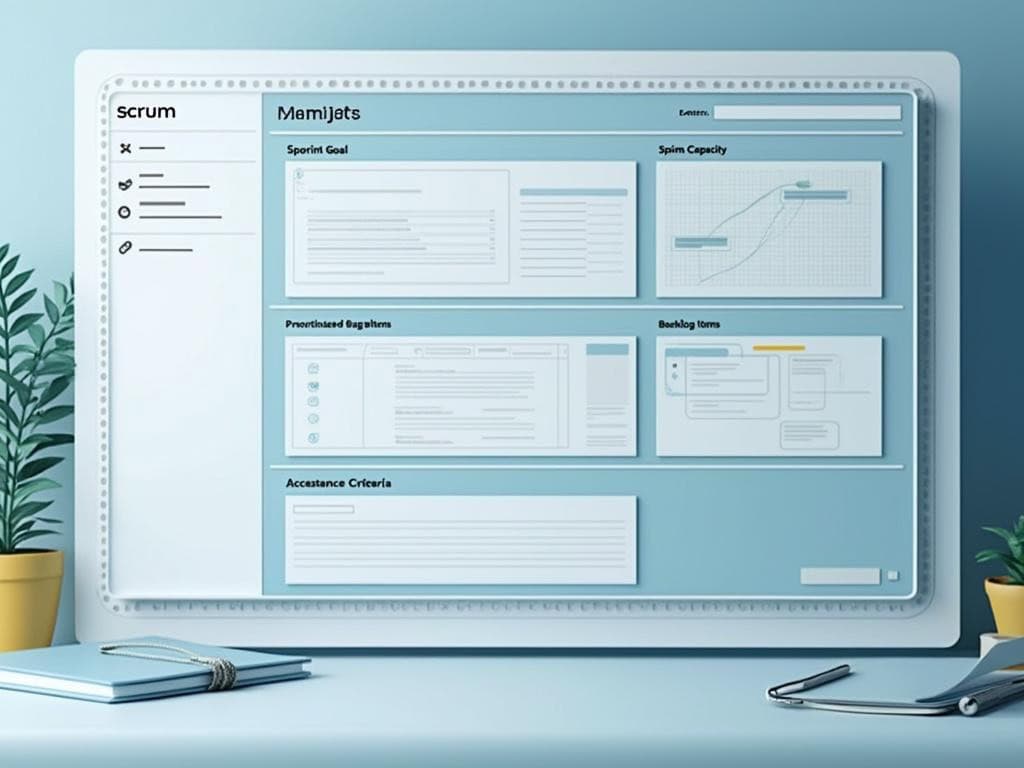
Scrum Planning Templates: Enhancing Agile Project Management
Scrum planning templates offer a powerful framework for Agile project management by creating clear, structured approaches to sprint planning and team collaboration. Implementing a comprehensive scrum planning template with SMART criteria helps organizations improve team alignment, boost project transparency, and deliver high-quality outcomes consistently across complex projects.
Key Takeaways
- A well-crafted scrum planning template centers on a clear, concise sprint goal that guides team efforts.
- Essential template components include sprint metadata, team capacity, prioritized backlog items, and detailed acceptance criteria.
- Digital collaboration tools like Jira and Asana support real-time template management and progress tracking.
- Structured templates can deliver up to 42% quality improvements and 24% enhanced responsiveness.
- Consistent template usage promotes team accountability, transparency, and continuous improvement.
A good scrum planning template focuses on practical organization rather than theoretical concepts. These templates serve as sprint planning guides that help teams define scope, allocate resources, and track progress efficiently.
The core components of an effective template include defined sprint duration, velocity measurements, and specific delivery commitments. You’ll find that templates bring structure to otherwise fluid Agile processes.
Digital tools have transformed how teams use planning templates. Modern platforms allow for quick updates, real-time collaboration, and automated tracking features that paper templates can’t match. Many organizations now use customizable digital templates that adapt to specific team needs while maintaining Agile principles.
Research shows that teams using standardized planning templates report higher satisfaction rates and better delivery consistency. The structure provided helps reduce miscommunication and keeps everyone focused on shared objectives.
For new Scrum teams, starting with a basic template and gradually adding complexity works best. This approach prevents overwhelming team members while still providing enough structure to guide effective planning sessions.
Advanced templates often include capacity planning features that account for team member availability, skill distribution, and potential blockers. These considerations make sprint commitments more realistic and achievable.
Template consistency across projects creates organizational knowledge that improves estimation accuracy over time. When teams use similar formats, they can compare performance metrics and refine planning approaches based on concrete data.
The most successful teams adapt their templates based on retrospective feedback, creating a cycle of continuous improvement in their planning processes. This flexibility ensures templates remain relevant and valuable as teams evolve.
“Embracing a structured Scrum planning template not only clarifies sprint goals and prioritizes tasks, but also cultivates a culture of accountability and continuous improvement within Agile teams. By leveraging these templates, organizations can significantly enhance project transparency and responsiveness, ultimately driving higher quality outcomes across complex initiatives.”
Sprint Goal: The Core of Effective Planning
Creating a clear sprint goal is fundamental to your scrum planning template success. This concise, one-sentence summary describes the primary objective your team aims to achieve during the sprint period. Your sprint goal should follow SMART criteria: Specific, Measurable, Achievable, Relevant, and Time-bound to maximize effectiveness.
A well-crafted scrum planning template always places the sprint goal at its center. You’ll find this approach prevents unnecessary detail overload when communicating with stakeholders while providing clarity and direction for team efforts. The collaborative creation of sprint goals enhances shared ownership and commitment among team members.
Essential Components of a Robust Scrum Planning Template
Your scrum planning template should include these key elements to support consistent and transparent project management:
- Sprint number, dates, duration, team members, and capacity
- Prioritized backlog items with detailed acceptance criteria
- Clear dependencies between tasks and user stories
- Definition of done criteria for all deliverables
- Task owners and their specific responsibilities
- Potential risks and mitigation strategies
This structured approach to project collaboration enables precise velocity tracking and balanced workload distribution. Leading digital tools like ONES Project, Jira, Trello, ClickUp, and Asana support real-time collaboration while providing customizable scrum planning template options for different team workflows.
Effective scrum planning templates also clearly delineate responsibilities and promote visual progress tracking through burndown charts. This approach supports continuous improvement through historical data analysis while enhancing team accountability and transparency. When implementing your scrum planning template, you should select appropriate digital tools matching your team’s specific needs and develop standardized templates aligned with organizational goals.
According to industry data, 87% of Agile teams adopt Scrum methodology, with structured sprint planning delivering quality improvements up to 250%. Teams using a consistent scrum planning template report 42% quality gains and 24% enhanced responsiveness to changing requirements. Additionally, 85% of Scrum practitioners report improved work-life quality when using proper planning structures.
For optimal results, integrate your scrum planning template into project management workflows that support Agile ceremonies including planning sessions, daily standups, sprint reviews, and retrospectives. This holistic approach to scrum planning template implementation creates scalable solutions used by global enterprises like Microsoft and Salesforce while facilitating smoother collaboration across different team roles.

Anatomy of a Robust Sprint Planning Template
A well-structured scrum planning template forms the backbone of successful Agile project management. Your template should include essential components that drive clarity and team alignment while maintaining focus on sprint objectives.
Every effective scrum planning template captures critical information to guide your team’s work. The foundation includes sprint identifiers (number, dates, duration), team composition details, and total capacity available. This structure helps you manage project dependencies efficiently while maintaining clear oversight.
Here are the key elements your scrum planning template should include:
- Sprint metadata (number, start/end dates, duration in days/weeks)
- Team roster with capacity allocations per member
- Clearly articulated sprint goal following SMART criteria
- Prioritized product backlog items with story points
- Detailed acceptance criteria for each backlog item
- Task breakdown with estimated hours and assigned owners
- Definition of Done criteria for quality assurance
- Identified dependencies and potential blockers
- Risk assessment section with mitigation strategies
- Daily scrum meeting schedule and participation guidelines
The power of a comprehensive scrum planning template lies in its ability to foster consistency across sprints. With standardized documentation, you’ll achieve more predictable outcomes and enable continuous improvement through comparative analysis of past performance.
Digital Tools for Scrum Planning Success
Modern scrum planning templates benefit tremendously from specialized digital platforms. These tools streamline collaboration and provide real-time visibility into sprint progress for all team members.
Leading solutions like ONES Project, Jira, Trello, ClickUp, and Asana offer customizable scrum planning template options that adapt to your specific workflow requirements. These platforms integrate seamlessly with broader project management systems, creating a cohesive environment for your Agile initiatives.
Your scrum planning template should support visual progress tracking through burndown charts and kanban boards. This visual approach helps teams quickly identify bottlenecks and make necessary adjustments before they impact delivery timelines.
When implementing your scrum planning template, ensure it facilitates role clarity across the team. Each task should have clear ownership, encouraging accountability while maintaining the collaborative spirit essential to Agile methodologies. This approach supports smoother project collaboration and reduces confusion during execution.
The effectiveness of your scrum planning template directly impacts project outcomes. Teams utilizing structured templates report up to 42% quality improvements and 24% enhanced responsiveness to changing requirements. By investing time in developing a comprehensive scrum planning template, you’re establishing the foundation for sustained Agile success.

Digital Tools and Collaboration Platforms
Finding the right tools for your scrum planning template implementation can significantly boost your team’s agility and efficiency. Today’s digital landscape offers numerous platforms specifically designed to support the unique needs of Agile teams implementing scrum methodologies.
Leading collaboration tools like ONES Project, Jira, Trello, ClickUp, and Asana provide robust support for creating and managing your scrum planning templates. These platforms excel at enabling real-time collaboration while seamlessly integrating with broader project management systems your organization may already use. Each tool offers customizable scrum planning template options that you can tailor to match your specific team workflows and project requirements.
When selecting a platform for your scrum planning template needs, consider how well it supports the full range of Agile ceremonies. Your tool should facilitate sprint planning, daily standups, sprint reviews, and retrospectives—all critical components of the scrum framework. The best project collaboration platforms make it easy to document decisions, track progress, and maintain transparency throughout each sprint.
Enterprise-Ready Solutions
The most effective scrum planning template tools scale to enterprise needs while maintaining ease of use. Global organizations like Microsoft and Salesforce rely on these scalable solutions to implement scrum planning templates across large, distributed teams. Your implementation can benefit from these battle-tested platforms that handle complex projects while keeping your scrum planning template accessible and actionable.
Your team’s ability to collaborate effectively often depends on having shared visibility into the sprint backlog and progress. Digital scrum planning template tools create this transparency by providing:
- Real-time status updates visible to all team members
- Customizable views for different roles and responsibilities
- Automated progress tracking against sprint goals
- Integration with reporting tools for stakeholder communications
- Templates for consistent sprint planning documentation
The right platform will also support the iterative nature of scrum methodology by making your scrum planning template easy to refine between sprints. This continuous improvement approach helps your team optimize workflows and increase productivity with each cycle.
When evaluating tools for your scrum planning template implementation, prioritize platforms that balance structure with flexibility. Your team needs enough guidance to maintain consistency but sufficient freedom to adapt the scrum planning template to emerging project needs and changing priorities.

Role Clarity and Team Dynamics
Your scrum planning template should clearly define roles and responsibilities for each team member. When you establish who’s responsible for what, you’ll prevent confusion and create accountability within your Agile team. A well-designed scrum planning template becomes the foundation for successful project collaboration and seamless workflow.
Team visibility is essential for effective scrum planning. Your template should incorporate visual tracking mechanisms like burndown charts that show progress toward sprint goals. These visual aids help team members understand exactly where the project stands and what needs attention.
Historical data analysis is another crucial component of your scrum planning template. By recording sprint outcomes, you’ll enable continuous improvement through data-driven decisions. This approach allows you to refine your scrum planning template with each iteration, making it increasingly effective.
Enhancing Team Performance
Your scrum planning template creates a framework for smoother collaboration across different roles. Consider including these key elements:
- Designated spaces for Product Owner priorities and vision statements
- Clear sections for Scrum Master facilitation notes and impediment tracking
- Team member capacity allocation with skill-matching considerations
- Technical debt and dependency tracking mechanisms
- Risk assessment and mitigation planning components
A comprehensive scrum planning template fosters transparency and shared understanding. When everyone can see the full picture of sprint objectives, tasks, and challenges, you’ll experience fewer miscommunications and more aligned efforts.
The right template structure supports effective daily standups by providing context for updates. You can incorporate sections for tracking blockers identified during these meetings, ensuring they’re addressed promptly rather than forgotten.
Using a consistent scrum planning template helps standardize your project leadership approach. This consistency creates predictability and comfort for team members, allowing them to focus on delivering value rather than figuring out processes.
Remember that your scrum planning template should be a living document that evolves with your team’s needs. Regular retrospectives offer perfect opportunities to gather feedback on the template’s effectiveness and make necessary adjustments.
By implementing a thoughtful scrum planning template that clarifies roles and enhances team dynamics, you’ll create the foundation for Agile success and more predictable project outcomes.
Projects with clearly defined roles and responsibilities are 27% more likely to succeed.
forbes.com
Measuring Scrum Effectiveness
Implementing a scrum planning template leads to measurable improvements in your project outcomes. With 87% of Agile teams adopting Scrum methodology, this framework has proven its value across industries. Teams using structured sprint planning templates report quality improvements up to 250%, demonstrating how critical proper planning is to project success.
Your scrum planning template serves as the foundation for tracking key performance indicators. When you consistently use these templates, you’ll experience 42% quality gains and 24% enhanced responsiveness to changing requirements. These improvements stem from having clear documentation of sprint goals, task assignments, and timeline expectations all in one accessible location.
Key Metrics for Scrum Planning Success
Track these essential metrics to evaluate your scrum planning template effectiveness:
- Sprint velocity – Measure how much work your team completes in each sprint
- Burn-down charts – Visualize remaining work versus time left in the sprint
- Story point completion rates – Track estimated versus actual completion
- Defect rates – Monitor quality improvements across sprints
- Team satisfaction scores – Gauge how the planning process affects team morale
The impact of effective sprint planning extends beyond productivity metrics. According to research, 85% of Scrum practitioners report improved work-life quality when using structured planning templates. This improvement occurs because well-designed scrum planning templates reduce ambiguity and help prevent scope creep.
The following table summarizes how scrum planning templates impact different aspects of project management:
| Metric | Average Improvement |
|---|---|
| Quality | Up to 250% |
| Responsiveness | 24% |
| Team Satisfaction | 85% |
| Project Visibility | 64% |
| Risk Management | 37% |
When implementing your scrum planning template, focus on consistent application across sprints. This consistency allows for better project integration and more accurate performance tracking. Compare velocity trends across multiple sprints to identify patterns and opportunities for process refinement.
Remember that your scrum planning template should evolve based on team feedback and changing project needs. Regular retrospectives provide valuable insights into how to optimize your templates. By continuously improving your scrum planning template, you’ll create a more efficient, transparent, and effective Agile project management environment.
Implementing Scrum Planning Templates: Next Steps
Your scrum planning template serves as the backbone for effective Agile project management. To fully implement these templates and maximize their benefits, you’ll need a structured approach that balances standardization with flexibility.
Start by selecting appropriate digital tools that match your team’s specific needs. Popular platforms like Jira, Trello, and Asana offer scrum bug tracking capabilities alongside customizable scrum planning template options. Consider your team size, project complexity, and integration requirements when making this choice.
Next, develop a standardized template that aligns with your organizational goals. Your scrum planning template should include:
- Sprint number, dates, and duration
- Team composition and capacity allocation
- Prioritized backlog items with clear acceptance criteria
- Dependencies and potential roadblocks
- Definition of Done criteria for quality assurance
- Task ownership and responsibility matrix
Training and Integration Strategy
Proper implementation requires more than just creating templates. Train your team thoroughly on template usage and Agile best practices. This investment in knowledge pays dividends through consistent application and reduced confusion.
The following elements should be included in your training approach:
- Hands-on workshops using actual scrum planning template examples
- Role-specific training for Product Owners, Scrum Masters, and Development Team members
- Regular feedback sessions to refine template usage
- Documentation of best practices and common pitfalls
Integrate your scrum planning templates into existing project management software workflows to avoid creating separate processes. This integration ensures your templates become part of the natural workflow rather than an additional burden.
Remember to regularly review and refine your templates based on team feedback. Your scrum planning template should evolve as your team matures and project requirements change. This continuous improvement approach mirrors the iterative nature of Agile itself.
By thoughtfully implementing scrum planning templates, you’ll create a foundation for predictable, transparent, and efficient project delivery that maintains the agility core to the scrum methodology.






